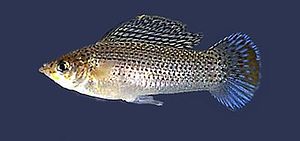Broad-fin fish
| Broad-fin fish | ||||||||||||
|---|---|---|---|---|---|---|---|---|---|---|---|---|

Broad-fin fish ( Poecilia latipinna ), male |
||||||||||||
| Systematics | ||||||||||||
|
||||||||||||
| Scientific name | ||||||||||||
| Poecilia latipinna | ||||||||||||
| ( Lesueur , 1821) |
The broad-fin fish ( Poecilia latipinna ) is a member of the viviparous toothcarp family . As an ornamental fish , it is usually kept in freshwater aquariums, even if in nature it inhabits not only freshwater, but also brackish and saltwater zones.
distribution
The natural range of the large fin fish includes the coastal regions on the Atlantic Ocean in the USA and Mexico , starting from southeastern North Carolina via Florida along the Gulf of Mexico to the Mexican Atlantic coast. In the USA, various breeding forms and cross-breeds of the broad-fin fish have been exposed, so that pure wild animals are only found in Mexico.
features
Male broad-fin males reach a length of 8 to 10 cm, females are 10 to 15 cm tall. The body is olive green with the belly side being lighter than the top. When the light comes in from the side, the fish appear silvery with pearly rows of scales. Alpha males have chests colored orange. The dorsal fin of the male animals is enlarged like a sail, mother-of-pearl and has numerous dark blue and black spots. The upper edge is orange-red. The caudal fin is orange and also spotted blue. The fins of the females are transparent. There are also piebald to almost black local forms.
Relationship to the Amazon Parrot
It was through genetic studies are evidence that the Amazonenkärpflinge by a single hybridization event between a female Atlantikkärpfling have arisen and a male Sailfin Molly 40,000 and 100,000 years ago, according to other, more recent information even before about 280,000 years ago.
Aquaristics
Cultivated forms of the white-mouthed larva are often offered in the trade. However, due to the easy cross-ability of the different Molly species, they can often not be traced back to a single basic species. A cultivated form based on the white-mouthed larva is the midnight molly, which is colored black and whose males show the typical orange fin border in the dorsal fin.
When it comes to keeping the animals, they have the same requirements as the closely related marigold . The animals feel most comfortable at temperatures between 27 and 28 ° C. In order to grow large specimens, the aquarium should hold at least 400 liters. When fed live feed, the animals become sexually mature too quickly; it should only be served in the first four weeks. After that, only dry food and algae food should be fed. With an average gestation period of four weeks, the females give birth to between 10 and 100 live young, which are already 8 mm long at birth.
literature
- Manfred K. Meyer, Lothar Wischnath, Wolfgang Foerster: Livebearers ornamental fish: Species of the world. Mergus Verlag für Natur- und Heimtierkunde Baensch, Melle 1985, ISBN 3-88244-006-6 .
- Bernhard Teichfischer: Guppy, platy, swordtail and molly: breeding forms of livebearers. Dähne Verlag, Ettlingen 2004, ISBN 3-921684-64-1 .
Web links
- Broad-fin fish on Fishbase.org (English)
- Poecilia latipinna inthe IUCN 2013 Red List of Threatened Species . Posted by: Contreras-Balderas, S. & Almada-Villela, P., 1996. Retrieved January 11, 2014.
Individual evidence
- ^ BJ Turner: The evolutionary genetics of a unisexual fish Poecilia formosa. In: C. Barigozzi (Ed.): Mechanisms of speciation. Alan R. Liss, New York, 1982. pp. 265-305.
